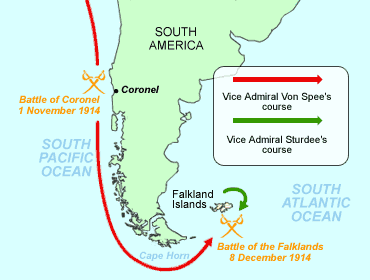

The sea lanes around Cape Horn were strategically important. These were the supply routes between the Indian and Pacific Oceans and the South Atlantic. Control of these waters was necessary to protect the merchant shipping which carried vital supplies for the war effort.
Download your free, print-friendly fact sheet about the 1914 Battle of the Falklands here.
On 1 November 1914 Britain suffered its worst naval defeat for over a century. Vice-Admiral Maximilian Graf Von Spee was in command of the German Imperial Navy’s East Asiatic Squadron. His Squadron of two armoured cruisers Scharnhorst and Gneisenau and three light cruisers Leipzig, Dresden and Nürnberg, were sailing eastwards across the Pacific towards the South American coast. Despite being out gunned the British Squadron, commanded by Rear-Admiral Sir Christopher Craddock, engaged the German cruisers off the coast of Chile near Coronel. HMS Good Hope and HMS Monmouth were both sunk with the loss of all lives, including Craddock. The light cruiser HMS Glasgow and an armoured merchant ship HMS Otranto escaped.
When news of the defeat at Coronel reached Britain the First Sea Lord Sir John Fisher ordered the battlecruisers HMS Invincible and HMS Inflexible to sail to Plymouth where they would be overhauled and made ready to sail to the South Atlantic. Vice-Admiral Sir Frederick Doveton Sturdee was appointed Commander in Chief of the Squadron. They sailed from Devonport on the 11 November.
On the 26 November the battlecruisers reached Abrolhos Rocks, Brazil where they would rendezvous with the armoured cruisers HMS Carnarvon, HMS Kent, HMS Cornwall and the light cruisers HMS Bristol and HMS Glasgow.
On the morning of the 7 December 1914 the British Squadron arrived at Port Stanley in the Falkland Islands where they were joined by the armed merchant cruiser HMS Macedonia. They began taking on supplies of coal (coaling) and conducting repairs so that they could resume the search for Spee’s Squadron the following day.
On the morning of the 8 December a look-out station sighted smoke from a ship’s funnel out to sea. Most of the British ships were still coaling in the harbour. Vice-Admiral Sturdee ordered his ships to get up steam and then went for breakfast.
Vice-Admiral von Spee was sailing his Squadron back to Germany to re-supply his ships. On the way Spee decided to destroy the base installations on the Falkland Islands. German intelligence did not know that the Royal Navy were there and Spee believed the Islands to be undefended. SMS Gneisenau and SMS Nürnberg approached Port Stanley to attack the wireless station. HMS Canopus an old pre-dreadnought that was defending the harbour opened fire at extreme range. Spotters on a hill were used to target the guns as the Canopus was hidden from the German ships by the land. The Gneisenau and Nürnberg continued to approach the harbour until they caught sight of the distinctive tripod masts of the British battlecruisers. Not wanting a fight with a superior force, Spee and his Squadron headed at full steam for the open sea.
(Image created by the BBC)
At 10.20am the signal for general chase was given. Invincible, Inflexible, Carnarvon, Cornwall, Kent and Glasgow went in pursuit of the German Squadron. Bristol and Macedonia went after the German transport ships and managed to sink the Baden and Santa Isabel, after removing their crews.
The British battlecruisers were faster than the German ships, they also outgunned them. At around 1pm the German ships came into range and Inflexible and Invincible opened fire.
Spee knew that he couldn’t out run the British ships. The Leipzig, Dresden and Nürnberg altered heading and were pursued by the Kent, Glasgow and Cornwall. The Invincible, Inflexible and Carnarvon stayed with the armoured cruisers Scharnhorst and Gneisenau who were covering the retreat of the German Squadron.
The German flagship Scharnhorst was sunk with all hands, including Vice-Admiral von Spee soon after 4pm. The Gneisenau sank at around 6pm. The Invincible, Inflexible and Carnarvon tried to pick up as many survivors as they could from the Gneisenau, but many men drowned in the cold Atlantic water. Reports from rescued German prisoners also suggested that there were hundreds of casualties on board the Gneisenau before it finally sank. The heavily armoured ships were able to sustain a lot of damage and still remain afloat.
The Kent caught up with the Nürnberg at around 5pm. Just over an hour and a half later the Nürnberg was on fire and had ceased firing. It eventually sank at about 7.30pm. Twelve men were rescued from the water although only seven survived.
The Glasgow pulled ahead of the other cruisers and got in range of the Leipzig at around 3pm. It was then joined by the Cornwall. The Leipzig had taken heavy damage and was on fire when it finally sank at around 9pm with only 18 survivors.
The Dresden managed to escape, helped in part by a reduction in visibility from some incoming bad weather. It was eventually found on March 14 1915 in a harbour on the Chilean island of Mas a Fuera (Selkirk Island). After the crew surrendered the ship was scuttled.
British casualties were light with minimal damage sustained to the ships. Vice-Admiral Sturdee praised the actions of his men particularly those working in the engine room, whose strenuous efforts enabled them to catch the German Squadron. Some of the ships even managed to exceed their normal top speeds. Several men were given commendations and received awards for their part in the Battle of the Falklands. Sergeant Charles Mayes on HMS Kent was awarded the Conspicuous Gallantry Medal for extinguishing a fire next to a live ammunition store and so preventing “a disaster which might have led to the loss of the ship”.
British news reports of the time considered the Battle of the Falklands to be a great victory for the Royal Navy which avenged the British defeat at Coronel.
